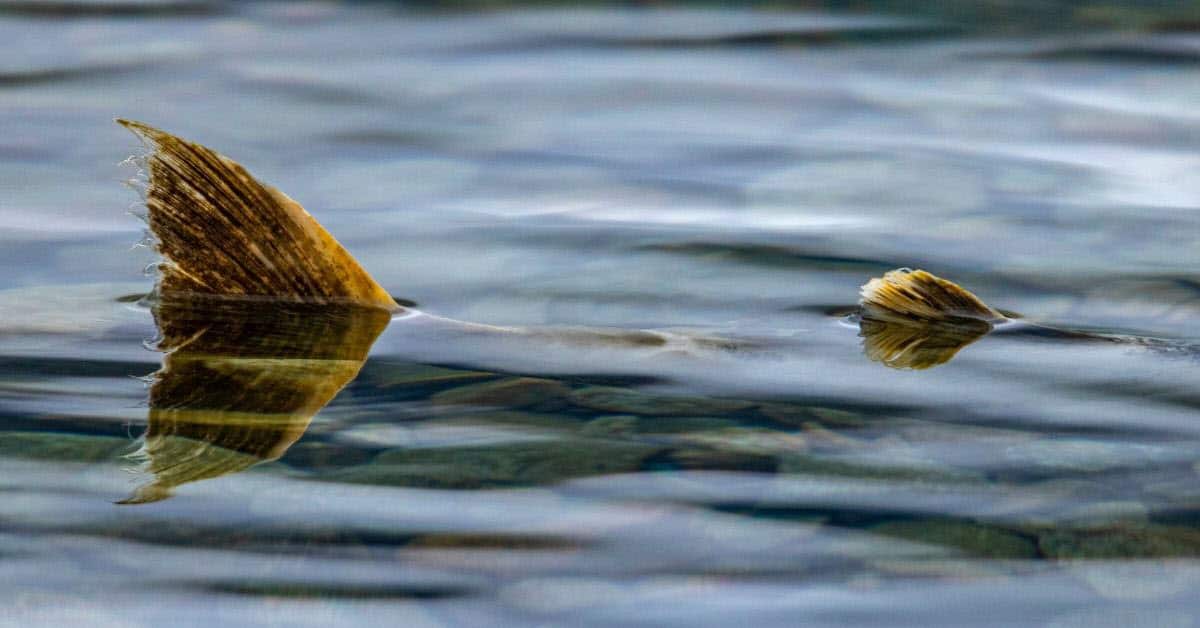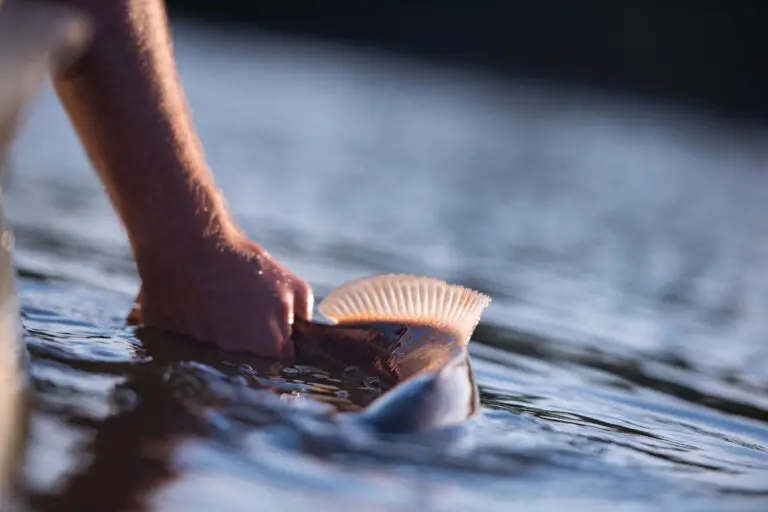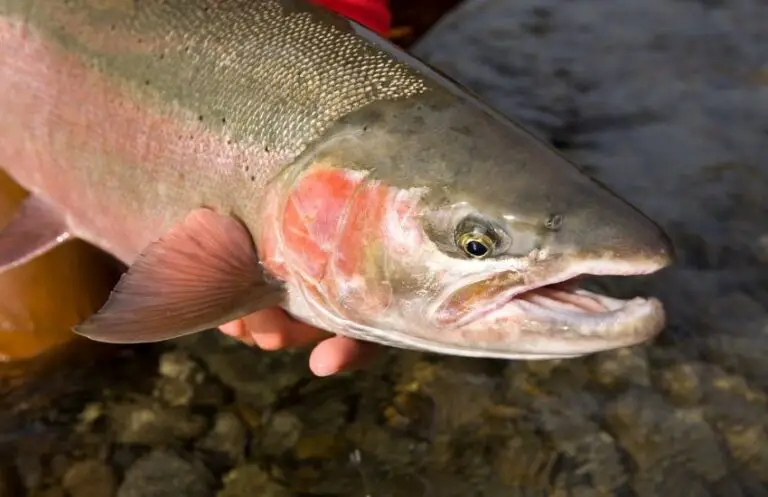Salmon Rigs For Bank Fishing: Best Rigs For Plunking, Drifting, And Casting
Fishing rigs are the combination of hooks, weights, snaps, and spreaders you add at the end of your fishing line. What makes salmon fishing rigs for bank fishing different from the rest are two things: the water speed and structure for fishing migratory lanes, riffles, and runs.
This hands-on guide shows how to build salmon rigs for bank fishing for plunking and drift fishing.
Let’s get started!
Plunking For Salmon
Plunking is a fishing method in a fixed location in a migration path of upstream swimming fish. Anglers cast and holster their rods in rod holders and wait for bites. Rather than waiting for the fish to come to them, plunkers cast their line into a migration path and wait patiently.
Cured salmon eggs are typically used for bait rigs while anglers keep an eye out on a rod holder that acts like fixed fishing poles with lures at the end.
Plunking has proven to be an effective fishing technique for several reasons:
- Salmon tend to be in a hurry to travel upstream and travel like race cars using currents like traffic lanes. They are not paying attention to the signs like monofilament fishing lines.
- They are somewhat predictable and look for the slower, more controlled currents (usually closer to the bank) to travel.
- Since they are in such a hurry, you can catch salmon using shiny lures with movement and noise, and bait scents drive them to the bait, both natural and artificial.

Drift Fishing For Salmon
Drift fishing is an effective way to target specific species of salmon such as Chinook or Coho. You can do it either by trolling with a boat and rod, using live bait, casting plugs into the water from shoreline areas, wade fishing in shallow waters at night; there are many techniques that work well for targeting these types of other salmon.
The important thing is to identify drift fishing water for a river correctly.
Here are the things to look out for:
- Fast running water, coming out of a rapid
- Slowly flowing out into a “tail out.”
- The top of the water is deep, fast, and swift.
- Look for a run without large boulders or rocks that would snag our rig along the bottom.
- Good current speed
The resistance from the current allows for our bait rigs to drag across the bottom as it drifts along. You will be casting your drift fishing rig against the current at a 45-degree angle.
Types Of Salmon Rigs That Work Great For Bank Fishing
1. Salmon Plunking Rig With A Single Bait
Salmon Plunking Rig With Single Spreader For A Spin-N-Glo Lure. The T-Spreader has advantages in allowing the bait to rotate without causing main line twist and movement in the current.
Parts For Single Spreader Salmon Plunking Rig
- Main line: 40 lbs monofilament
- Spreader: 3-way T-spreader. Alternatively, you can use a bead chain with a snap swivel.
- Hook: 4/0 octopus hook
- Beads: (2) 6-mm red beads
- Lure: Spin-N-Glo lure (size 2)
- Weight: 6-10 oz lead. Use a pyramid type for a sandy bottom.
- Dropline for weight: 1-foot in length. 20 lbs monofilament for a rocky bottom. Use heavier test for a sandy bottom.
- Dropline for hook: 1.5 to 2-foot in length, 30 lbs monofilament
Steps To Setup Single Spreader Salmon Plunking Rig
- Load the main line onto the reel spool. I recommend a 40-lbs monofilament line.
- Tie the main line to the top of the spreader using the “improved cinch” knot.
- Tie the octopus hook to the hook drop line using the “egg loop” knot.
- Feed the two red beads through the hook drop line. These beads will act as a buffer between the hook knot and the Spin-N-Glo lure coming next.
- Feed the tail end (tapered end) through the hook drop line.
- Tie hook drop line to the T-bar of the spreader using the improved clinch knot.
- Tie a double loop knot on one end of the weight drop line.
- Attach weight pulling through the loop.
- Tie the weight drop line to the bottom of the spreader using the improved clinch knot.
- Run “naked” or add eggs, prawns, or shrimp to hook.
2. Salmon Plunking Rig With Dual Baits
Salmon Plunking Rig With Dual Spreaders For Two Spin-N-Glo Lures. The T-Spreader and Y-spreader for these bait rigs allow two baits to rotate without causing main line twist and movement in the current.
Parts For Dual Spreader Salmon Plunking Rig
- Main line: 40 lbs monofilament
- Spreader: 3-way T-spreader. Alternatively, you can use a bead chain with a snap swivel.
- Spreader #2: 3-way Y-spreader
- Hook: (2) 4/0 octopus hooks
- Beads: (2) 6-mm red beads
- Lure: (2) Spin-N-Glo lures (size 2)
- Weight: 6-10 oz lead. Use a pyramid type for a sandy bottom.
- Dropline for weight: 2-foot in length. 20 lbs monofilament for a rocky bottom. Use a heavier test line for a sandy bottom.
- Dropline for hook: (2) 1.5 to 2-foot in length, 30 lbs monofilament
Steps To Setup Dual Spreader Salmon Plunking Rig
- Load the mainline onto the reel spool. I recommend a 40-lbs monofilament line.
- Tie the mainline to the top of the spreader using the “improved cinch” knot.
- Tie the octopus hook to the hook drop line using the “egg loop” knot.
- Feed the two red beads through the hook drop line. These beads will act as a buffer between the hook knot and the Spin-N-Glo lure coming next.
- Feed the tail end (tapered end) through the hook drop line.
- Tie hook drop line to the T-bar of the spreader using the improved clinch knot.
- Tie a double loop knot on one end of the weight drop line.
- Attach weight pulling through the loop.
- Tie the weight drop line to the bottom of the spreader using the improved clinch knot.
- Run “naked” or add eggs, prawns, or shrimp to both hooks
3. Salmon Bobber Rig For Drift Fishing
This bobber rig is excellent for fall salmon fishing. You can rig this with cured salmon eggs bait or jig lures. This rig specifies an egg hook, but you can replace this hook with an octopus hook for other baits.
Parts For Salmon Bobber Rig
- Bobber stop
- Float: 1 oz slip bobber
- Hook: 3/0 Gamakatsu single egg snell hook
- Weights: (2) 1/2 oz egg sinker
- Beads: (2) red beads
- Swivel: 2-way swivel
- Dropline for weight: 2-foot in length. 30 lbs braid for a rocky bottom. Use a heavier test line for a sandy bottom.
- Dropline for hook: 1 to 1.5-foot in length, 20 lbs monofilament
- Pautzke Balls O’ Fire Salmon Eggs Bait
Steps To Setup Salmon Bobber Rig
- Load the mainline onto the reel spool. I recommend a 40-lbs monofilament line.
- Thread the bobber stop, then one red bead through the mainline.
- Tie the mainline to the top of the bobber using the “improved cinch” knot. Ensure that the bead is between the bobber stop and the bobber.
- Tie the weight drop line to the bottom of the bobber using the “improved cinch” knot.
- Thread the two egg weights through the sinker drop line.
- Run a bead after the weights and then tie the sinker drop line to the swivel.
- Tie the hook drop line to the bottom of the swivel using the improved clinch knot.
- Tie the egg hook to the hook drop line using the “egg loop” knot.
4. Salmon Flasher Trolling Rig
This rig with 360 flashers and Brad’s Super Bait is ideal for catching spring Chinook! The difference between flashers and dodgers is how they move through the water. The flashers rotate 360 degrees while the dodgers sway side-to-side. These are two different types of attractors. Flashers tend to work better in faster waters.
This rig alternatively attaches to a downrigger. This rig is one of the most direct methods – mainline to sinker to flasher to cut plug.
Parts For Salmon Flasher Trolling Rig
- Weight slider: Weight slider with Duo lock clip
- Beaded chain: 8MM bead with 6-bead chain swivel
- 11-inch troll flasher
- Weight: 6-10 oz lead. Use a pyramid type for a sandy bottom.
- Dropline for flasher: 3-foot length of a 40 lbs monofilament line.
- Dropline for a plug: 3-foot length of a 30 lbs fluorocarbon line.
- Plug: Mini cut plug with dual 4/0 barbless hooks tied two inches apart.
Steps To Setup Salmon Flasher Trolling Rig
- Load mainline loaded with 40-lbs braided line.
- Thread the bobber stop, then one red bead through the mainline.
- Tie the mainline to the top of the duo lock and weight slider.
- Secure the duo lock to the beaded weight slider
- Tie the weight drop line to the bottom of the bobber using the “improved cinch” knot.
- Thread the two egg weights through the sinker drop line.
- Run a bead after the weights and then tie the sinker drop line to the swivel.
- Tie the hook drop line to the bottom of the swivel using the improved clinch knot.
- Tie the egg hook to the hook drop line using the “egg loop” knot.
Knots For Building Salmon Fishing Rigs
How To Tie The Improved Clinch Knot
Also known as the “fisherman’s knot,” the improved clinch knot is useful for tying off hooks and leaders. Learn how to tie the improved clinch knot here:
How To Tie An Egg Loop Knot
This knot allows you to change out the weight or other components for adaptability. Learn how to tie the egg loop knot here:
How To Tie A Double Uni Knot
The double uni knot is one of the best knots for tying a monofilament to braid directly. Learn how to tie the double uni knot here:
Great Plugs And Twitch Bait For Salmon Drift Fishing
Plugs are best fished on a line, by themselves, not behind a flasher. This lure initiates a wounded fish.
- Brad’s Cut Plugs – Comes with a split-cavity design to hold filets. It has a wounded baitfish action that gets their attention. The UV reflective paint makes it easy to spot.
- Brad’s Super Bait Fishing Lure (Lemon Lime) – This bait-holding lure attracts fish with a super rotating action. It is proven very effective for Fall Chinook and Coho salmon fishing. It can be fished by trolling, casting, plunking, or back bouncing. Add your scent or filet.
Salmon Lures Perfect For Bank Fishing Casting And Drifting
Salmon fishermen use many techniques to get the attention of migrating salmon. Spin-N-Glo’s and flashers make noise and movement that work in the murkiest waters.
- Dr. Fish Salmon Spoon Lures (5 pack) – Perfect for long casting, diving fast. Highly reflective 1/2 oz cast trolling spoon with treble hook.
- Wicked Lures Pink-Pink King Killer – Designed to cast, troll, back bounce, and plunk. This rig comes with a 2/0 Gamakatsu red octopus hook and a 30 lbs 6′ leader.
- Sconqaek Soft Plastic Shrimp Lures (10 pack) – Includes built-in hook with fluorescent material, luminous bead, and 3-inch leader. The size is 7.15 inches and 5.2 g.
- Wordens Spin N Glo Winged Drift Bobbers – Great for plunking rigs! Size 8 (3/4-inch long, 1/2-inch wide [without wings, approx. 1-inch wide with wings]) – 12 pack.
- Peetz 360 Flasher – ‘Stryke Zone’ – Attach is a 7″ 360 flasher before baits to grab attention. These stainless steel and mylar devices last for prolonged use.
- Corkie yarn rig – Tie a red or pink colored twine to a bare 4/0 octopus hook and a cookie using an egg loop knot. The corkie yarn rig is great for drift fishing.
- Salmon Eggs On Hook – Watch how to attach salmon eggs to a hook properly.
Baits For Salmon Plunking
The fresh bait of choice for Northwest salmon anglers is salmon eggs. These are often hard to find naturally since Grizzly bears like them too. So the best place to get these is at the local bait shop. There are also synthetic versions available.
Coon shrimp is another excellent choice. These cured and dyed shrimp are irresistible to steelhead and chinook salmon.
Other natural baits include:
- Brined Herring
- Herring Filet
- Anchovies
- Atlantic Prawn
- Pink Worms
- Plastic Eggs To Hold Salmon Eggs
Applying Scents For Salmon Twitching Jigs
Addicted Fishing has one of the best videos explaining scents for salmon lures and how to apply them.
Commonly Fished Salmon Species
Fishermen target five non-commercially salmon fishing species:
- Chinook Salmon – Also known as king salmon
- Coho Salmon
- Pink Salmon
- Chum Salmon
- Sockeye Salmon
- Atlantic Salmon
- Steelhead Salmon
Conclusion
This article outlines the four best rigs and setups I have found that work great for fishing from the bank, trolling, or drift fish.
- Salmon plunking rig with a single spreader has one Spin-N-Glo’s and a single bait hook.
- Plunking rig with two spreaders allows for 2 Spin-N-Glo’s and bait hooks.
- Salmon bobber rig and set up for salmon egg bait or jig lures.
- You outfit the salmon flasher trolling rig with dual 4/0 barbless hooks.
You also learned about how to tie the improved clinch, egg loop, and uni knots.
I recommended several salmon lures and plugs you will find helpful.
Lastly, you learned about bait scents that drive salmon crazy and how to apply them.








